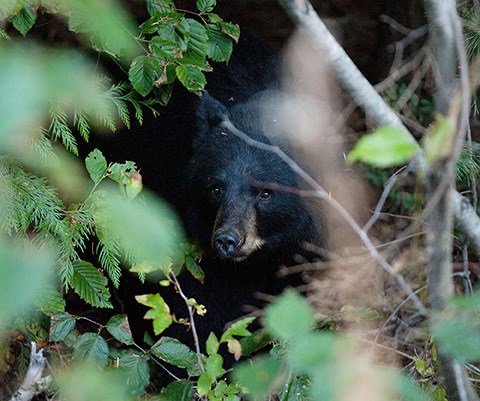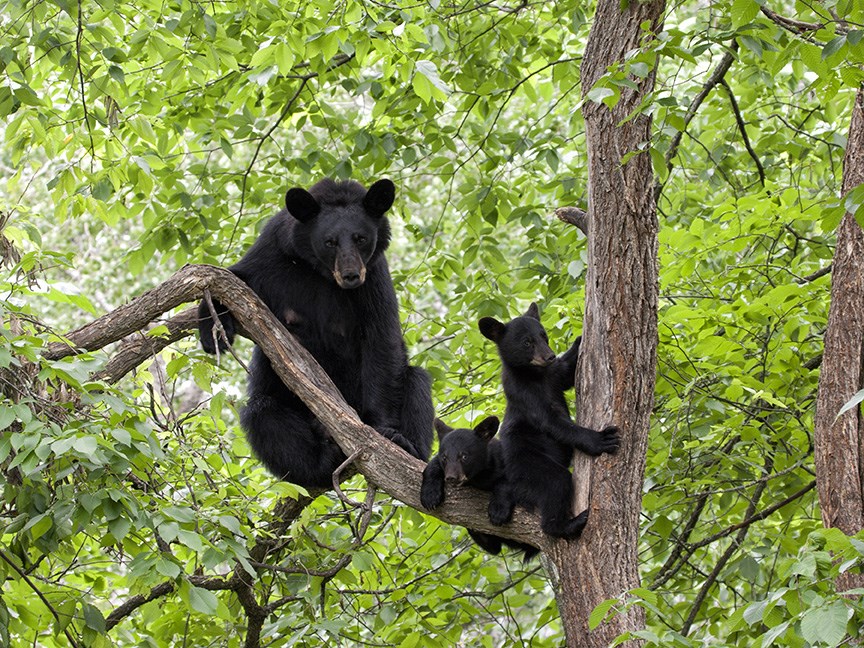Bears, specifically black bears, come out of hibernation in April ã and they are hungry.
According to Meg Toom, Squamishãs community coordinator for WildSafeBC, they have lost a third of their weight by spring.
ãItãs not muscle weight; itãs the fat theyãve stored before going to den in the winter. Theyãre not exactly lean, but theyãre hungry.ã
Yes, I can imagine they would be plenty hungry after a four-month fast, and looking for food to replenish that fat loss.ô So what does a large mammal eat to replenish 100 to 200 kilos of fat?
ãIt depends on the weather, but mainly dandelions, grass, berries, itãs basically salad.ã

Well, who says you canãt put on weight eating salad? The trick though, is you have to eat a lot of it. And just like humans, the attraction of easy, high caloric food ãjunk food ã is hard to resist if available.ô With bears, junk food is human garbage. Last springãs cold, wet weather delayed the growth of natural black bear foods, and that may have contributed to an attack in the Garibaldi Highlands.
ãOpen garbage, bird feeders, those are sources we donãt want them to become food-conditioned to. Bears are intelligent, curious animals they will take advantage of human food resources if given the chance,ã explains Toom.
In 2005 the District, in cooperation with Carneyãs Waste Systems introduced the lockable garbage tote. Unfortunately, the brass carabiners on those totes were not as impregnable to bears as originally thought, and are now being replaced with more durable stainless steel locks. By all reports, they are having great success in preventing bear incursions with those (they are tested by WildSafeBC), and the replacement of the brass carabiners continues.
Black bear encounters are the most reported wildlife encounter to conversation officers, at 82 per cent of all calls or 472 total reports in 2017 (cougars are second at eight per cent and coyoteãs at three per cent).
Last May was a particularly active month for black bear encounters with 109 calls to conservation officers, over previous yearsã averages of 35.
ãBears know you are there even if you donãt see them, they hear you, smell you. Eventually, it starts to erode their natural weariness, and they can get curious.ã Toom advises, ãyou never want bears to feel comfortable around humans.ã That means being loud out on the trails, and not just with bear bells. ãUse your voice, be loud, let them know youãre out there.ã
There lies much of the challenge in ôÕÑ¿èÓ¿ºýºwhen it comes to managing human and wildlife interaction. Squamish, itãs no secret, has an inordinate amount of active people. Mountain biking season is already here, and with it, dozens, if not hundreds of enthusiasts out on wilderness trails, add in dedicated hikers and trail runners and it can be a challenge to limit human/bear conflict.
Last year, when a mother bear and her two cubs took up residence for the spring and summer near the Mashiter Trail above the Highlands, the District and WildSafeBC took the proactive measure of putting up signs. Making trail users aware of the wildlife in the area, and recommending precautions.
ãThey were habituated to humans, but not food conditioned, thatãs when you get a high potential for conflict.ã Toom sees the result as a success, with bears living relatively close to humans, but sticking to wild food sources and not becoming nuisance bears.
ãSheãll be kicking out her cubs this year now that theyãre yearlings, so hopefully they will continue the way they have, and avoid human food sources.ã
Toom adds that often people ãkillã bears with kindness. They treat encounters with bears as a wildlife viewing opportunity, taking pictures, standing around watching them quietly. This only adds to bear habituation and can encourage a bearãs natural curiosity. They might start to approach people, or in some cases become aggressive. Although that is not their natural tendency, black bears evolved to be cautious and even shy, but thereãs a limit. They are omnivores and opportunistic eaters, sometimes they will hunt small mammals, but are just as happy to scavenge dead carcasses left by more dedicated predators, like cougars.
According to Stephen Herrero, author of Bear Attacks: Their Causes and Avoidance, long considered the most definitive work on bear/human conflicts, playing dead in the face of a black bear attack is simply presenting yourself as an hors-dãoeuvre.
While Black bear attacks are rare, an aggressive black bear, unlike with grizzlies, are best met with as much aggression as you can muster, according to Herrero.
ãBlack bears usually show defensive behaviour before they become aggressive. It can start with chuffing sounds, which is them saying, ãyouãre too close, Iãm uncomfortable.ã They may also get on their hind legs, which is not a sign theyãre going to attack, it means they are trying to figure things out, pick up scents, get a better view,ã says Toom.

You cannot outrun a bear as they can run as fast as 40 kilometres per hour and can climb trees almost as fast. However, those abilities are usually employed to avoid people, not stalk them. But says Toom, younger bears, under five, can find themselves in unwanted circumstances simply due to their inexperience. This means, we humans have to be the adults and take measures to avoid encounters.
ãBe alert when out on the trails,ã says Toom. If you see fresh scat, you know bears or a bear are in the vicinity, so make lots of noise, and give them the chance to get out of the area.ã
She adds that if you do encounter a bear you should back away slowly, if it is persistent, then deploy bear spray. If you donãt have bear spray (f you are a regular on the trails you should), then throw rocks. Also, in bear country, Toom stresses, never let your dog off leash.
Despite being large mammals, bears can and do live near urban areas. Their populations are very healthy, but allowing them food rewards will only lead to their destruction.
As Toom explains, ãhuman food sources can jack up bear populations.ã If bears come to rely on that, they will need human food sources to support their population beyond what natural sources would otherwise support.
ã[Female] bears that breed this spring have whatãs called delayed implementation,ã says Toom. ãTheir eggs donãt become viable until the fall when their bodies have determined whether or not theyãve consumed enough calories during pregnancy.ã
In other words, given just natural food sources nature will take care of itself.




